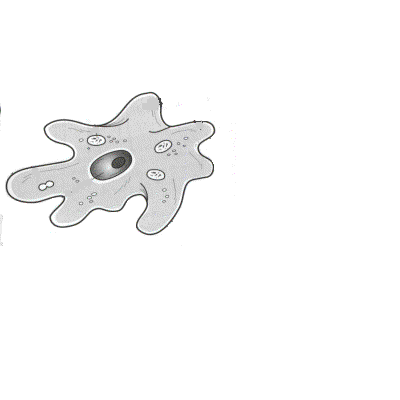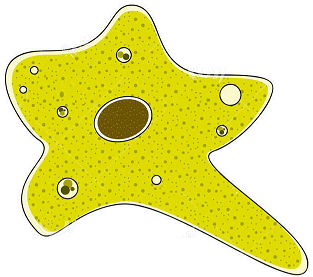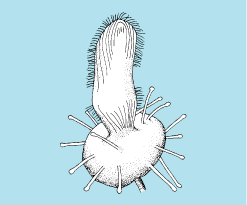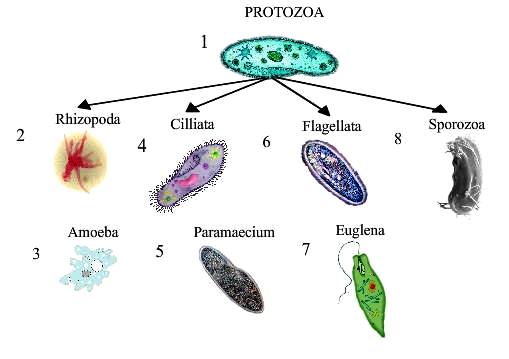Phylum Protozoa
Table of Content |

 - All unicellular (or acellular) eukaryotic animals.
- All unicellular (or acellular) eukaryotic animals.
- Most primitive (Gr. Porots = first + zoon = animal) organisms considered animals because of heterotrophic nutrition and motility.
- Although the whole body is a single minute cell.
- About 50,000 species (30,000 present and 20,000 extinct) are so far known.
- It is 3rd largest phylum.
Brief History
-
One celled body performs all the biological activities like multicellular animals. So they are termed as "Acellular" organism, proposed by Dobell.
-
Protozoans were first studied by Leeuwenhoek. And the name Protozoa was coined by Goldfuss.
-
The branch of study of protozons is known as Protozoology.
Salient Features
(1) Protozoans are the simple and primitive organisms
(2) Body level of organisation of Protozons is Protoplasmic level.
(3) They are free living or parasitic.
(4) Consists of uninucleate or multinucleate protoplasm mostly naked or some have body bounded by delicate membrane or a firm pellicle; Lorica or shell.
(5) In few groups of protozoa CaCO3 & Silica shell's exoskeleton is found. Example: Radiolarian group & Foraminiferan group.
(6) Number of nuclei varies from one to many. Few show nuclear dimorphism. Example: Paramoecium.
(7) Body performs all necessary biological activity so in them sub cellular - Physiological division of labour is found.
(8) All the free living forms are aquatic.
(9) They are asymmetrical or radially symmetrical or bilaterally symmetrical.
(10) They are unicellular (acellular).
(11) They have protoplasmic grade of organization.
(12) Locomotion is by means of-
(a) Finger-like Pseudopodia e.g. Amoeba
(b) Whip like Flagella e.g. Euglena
(c) Hairy cillia e.g. Paramoecium
(d) By contraction
(e) No motion
(13) Nutrition of Protozoans are mainly holozoic (Amoeba), Mixotrophic. (Euglena), Parasitic, Saprozoic (Plasmodium) and Digestion is intracellular take, place in food vacuole.
(14) Digestion is intracellular
(15) Respiration and Excretion take place by exchange of gases through body surface. Some excretion may occure through contractile vacuole. Nitrogenous waste is Ammonia. Some fresh water protozoans get rid of excess water through contractile vacuole known as Osmoregulation.
(16) In fresh water protozoans osmoregulation is carried out by the contractile vacuoles.
(17) Encystment is a common phenomenon
(18) Reproduction occurs by asexual and sexual methods. Reproduction takes place by
Asexual:
(a) Binary fission (Amoeba)
(b) Transverse fission (Paramoecium)
(c) Longitudinal fission (Trypansoma, Euglena)
(d) Multiple fission (Plasmodium)
(e) Budding
Sexual:
(a) Syngamy (Plasmodium), Conjugation (Paramoecium) also form cyst which help in unfavourable condition for reproduction of organism.
(b) They do not have natural death because in unicellular animals there is no division of somatoplasm & germplasm so these are considered as immortal.
|
Classification of Protozoa
Class 1. Flagellata or Mastigophora
(1) The body is covered by a thin pellicle or cuticle.
(2) The locomotory organs are flagella.
(3) The contractile vacuoles are present in fresh water forms with accessory vacuoles.
(4) Chloroplasts are found in some forms.
(5) They may be free living or parasitic.
(6)The class flagellata has been divided into eight orders. They are as Chrysomonadina, Cryptomonadina, Euglenoidea, Phytomonadina, Dinoflagellata, Cystoflagellata, Protomonadina and Polymastigina
(7) Examples: Chrysamoeba, Cryptomonas, Euglena, Volvox, Chlamydomonas, Noctiluca, Mastigamoeba, Monal, Bado, Trypanosoma, Leishmania, Proterospongia etc.,
Class 2. Rhizopoda
(1) There is no definite cell wall or pellicle
(2) There is no definite shape
(3) The locomotory organs are pseudopodia
(4) There is no permanent mouth or anus.
(5) The contractile vacuoles are present in the fresh water forms.
(6) The rhizopoda has been divided into five orders. They are as Lobosa, Filosa, Foraminifera, Heliozoa and Radiolaria.
(7) Examples: Amoeba, E. histolytica, E.coli etc.
Class 3. Ciliophora
(1) The body is covered by thin pellicle
(2) They have a fixed permanent shape
(3) The locomotory organs are cilia
(4) Tentacles are present
(5) The class ciliophora is divided into two sub-classes, namely Ciliata and Suctoria.
Sub-class 1. Ciliata
(1) Cilia are present throughout life.
(2) Tentacles are absent
(3) Mouth and cytopharynx are usually present. Cytopyge is a temporary anal aperture.
(4) Contractile vacuoles are present.
(5) Trichocysts, organs of offense and defence are present in certain forms.
(6) Examples: Paramecium, Stylonchia Vorticella, etc., Paramecium is filter feeder.
(1) Cilia are present only in the young conditions and adults are devoid of them.
(2) Tentacles are present in the adult
(3) One to many contractile vaculoes are present
(4) Examples: Acineta, Dendrocometes, Dendrosoma, etc.,
Class 4. Sporozoa
(1) They are exclusively endoparasitic
(2) The body is covered by pellicle.
(3) Reproduction takes place by spore formation
(4) The class is divided into two sub-classes, namely, Telosporidia and Neosporidia
Sub-class 1. Telosporidia
(1) The spores do not contain polar capsules or filaments
(2) The life history ends with the formation of spores.
(3) The spore cases are simple and contain many spores
(4) Examples: Monocystis, Gregarina, Isopora, Eimeria, Plasmodium, Babesia, etc.,
Sub class 2. Neosporidia
(1) The trophozoite is amoeboid multinucleated
(2) Spore cases are complex usually having a single germ
(3) Examples: Nosema, Myxidium, Globidium, etc.


Question 1: The class of phylum protozoa to which ‘noctiluca’ belongs, is
(a) Rhizopoda
(b) Sporozoa
(c) Mastigophora
(d) Ciliata
Question 2: The main basis of classification of phylum protozoa is
(a) Size
(b) Locomotory organelle
(c) Shape
(d) Number of nuclei
Question 3: In protozoa contractile vacuole is generally absent in the class
(a) Rhizopoda
(b) Sporozoa
(c) Ciliata
(d) Flagellata
Question 4: The class of Trichonympha is
(a) Calcaria
(b) Scyphozoa
(c) Sporozoa
(d) Mastigophora
Question 5: Which is not the characteristic of phylum protozoa?
(a) Pseudopodia
(b) Binary fission
(c) Contractile vacuole
(d) Cell membrane as body covering


| Q.1 | Q.2 | Q.3 | Q.4 | Q.5 |
| c | b | b | d |
Related Resources
-
Click here to refer the Useful Books of Biology for NEET (AIPMT)
-
Click here for Study Material on Animal Kingdom
To read more, Buy study materials of Animal Kingdom comprising study notes, revision notes, video lectures, previous year solved questions etc. Also browse for more study materials on Biology here.
View courses by askIITians


Design classes One-on-One in your own way with Top IITians/Medical Professionals
Click Here Know More

Complete Self Study Package designed by Industry Leading Experts
Click Here Know More

Live 1-1 coding classes to unleash the Creator in your Child
Click Here Know More

a Complete All-in-One Study package Fully Loaded inside a Tablet!
Click Here Know MoreAsk a Doubt
Get your questions answered by the expert for free



